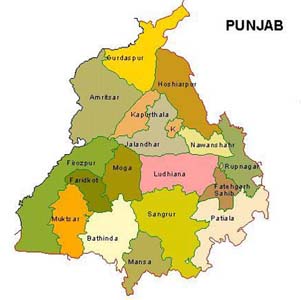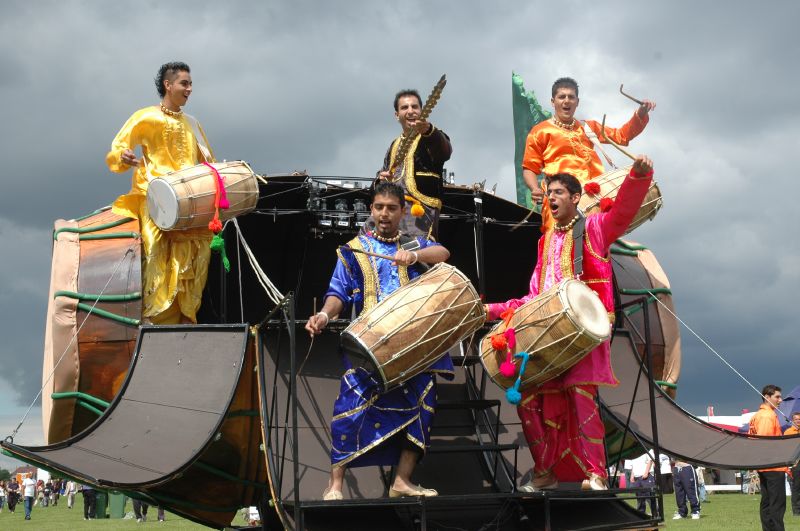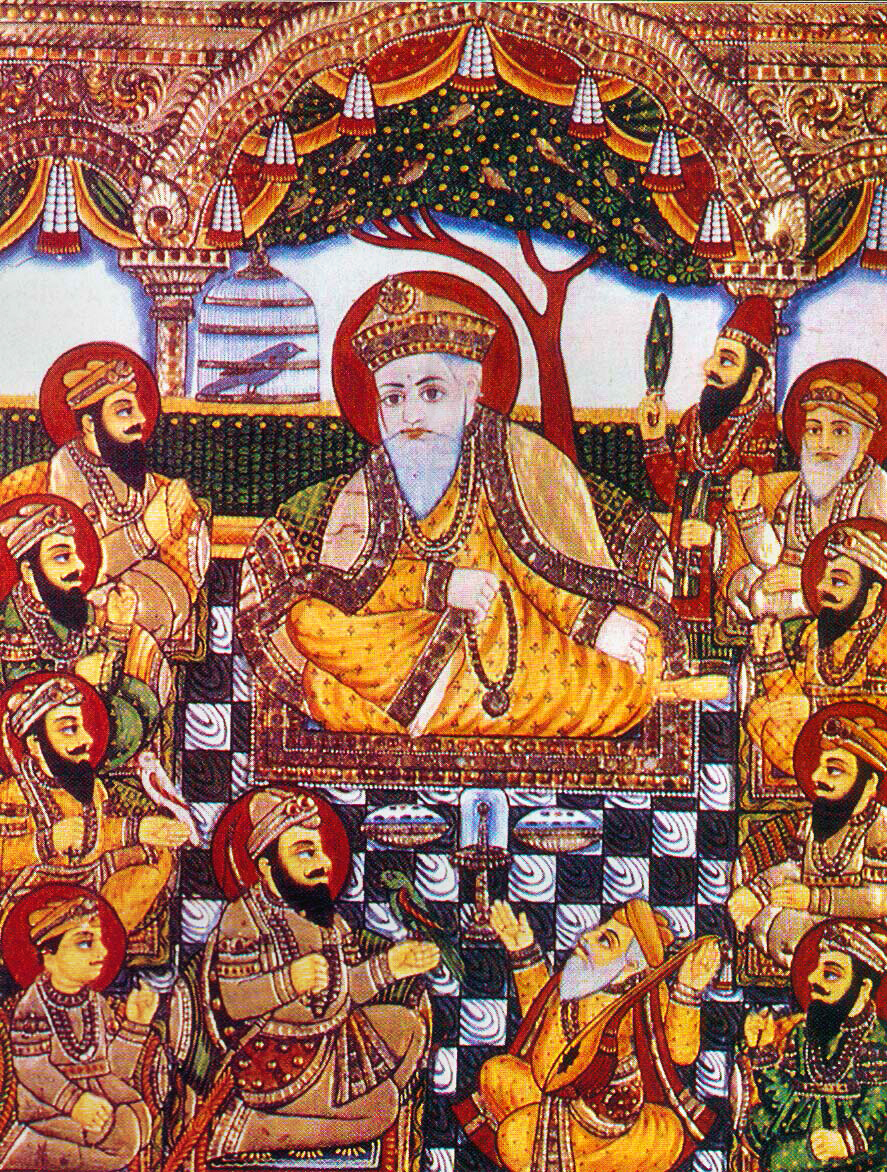Agriculture is the largest industry in Punjab, it is the largest single provider of wheat to India. Other major industries include the manufacturing of scientific instruments, water meter, electrical goods, financial services, machine tools, textiles, sewing machines, sports goods,starch, tourism, fertilizers, bicycles, garments, and the processing of pine oil and sugar. Punjab also has the largest number of Steel Rolling Mill Plants in India which are located in Steel Town Mandi Gobindgarh, District Fatehgarh Sahib.
Wednesday 23 March 2011
THE PUNJAB
PUNJABI FOOD
Punjabi food is now famous in the whole world.can be non-vegetarian or completely vegetarian. One of the main features of Punjabi cuisine is its diverse range of dishes. Home cooked and restaurant Punjabi cuisine can vary significantly, with restaurant style using large amounts of clarified butter, known locally as ghee, with liberal amounts of butter and cream with home cooked concentrating on mainly upon preparations with Whole Wheat, Rice and other ingredients flavored with masalas (spices). Roh Di Kheer, is cooked using rice. Rice is cooked for a long time in sugar cane juice.Within the area itself, there are different preferences. People in the area of Amritsar prefer stuffed parathas and milk products. In fact, the area is well known for quality of its milk products. There are certain dishes which are exclusive to Punjab, such as Mah Di Dal and Saron Da Saag (Sarson Ka Saag). The food is tailor-made for the Punjabi lifestyle in which most of the rural folk burn up a lot of calories while working in the fields. The main masala in a Punjabi dish consists of onion, garlic and ginger. Tandoori food is a Punjabi speciality especially for non-vegetarian dishes. Many of the most popular elements of Anglo-Indian cuisine - such as Tandoor, Naan, Pakoras and vegetable dishes with paneer - derive from the Punjab.
BHANGRA
In modern times, men also wear turla, the fan attached to the pagadi. Colorful vests are worn above the kurta. Fumans (small balls attached to ropes) are worn on each arm.Bhangra lyrics, always sung in the Punjabi language, generally cover social issues, such as love, relationships, money, dancing, getting drunk and marriage. Additionally, there are countless bhangra songs devoted to Punjabi pride themes and Punjabi heroes. The lyrics are tributes to the rich cultural traditions of the Punjabis. In particular, many bhangra tracks have been written about Udham Singh and Bhagat Singh. Less serious topics include beautiful ladies with their colorful duppattas and dancing and drinking in the fields of the Punjab.
Bhangra singers do not sing in the same tone of voice as their Southeast Asian counterparts. Rather, they employ a high, energetic tone of voice. Singing fiercely and with great pride, they typically add nonsensical, random noises to their singing. Likewise, often people dancing to Bhangra will yell phrases such as hoi, hoi, hoi; balle balle; chak de; oye hoi; bruah (for an extended length of about 2–5 seconds); haripa; orch-ch (mostly used as slow beats called Chummer/Jhoomer) to the music.
Many different Punjabi instruments contribute to the sound of bhangra. Although the most important instrument is the keyboard, bhangra also features a variety of string and other drum instruments.
The primary and most important instrument that defines bhangra is the dhol. The dhol is a large, high-bass drum, played by beating it with two sticks - known as daggah (bass end) and tilli (treble end). The width of a dhol skin is about fifteen inches in general, and the dhol player holds his instrument with a strap around his neck.
RELIGION
Science, history and religion has played an important role in shaping Punjabi ethnic identity and it is not uncommon for Punjabis to generally treat their religious identity as synonymous with their ethnic identity or at least a combined identity that differentiates them from others. Punjabis belong largely to three major religions: Islam, Hinduism and Sikhism. There are also small number of Christians, Jains and Buddhists.Muslim Punjabis are the largest group in the Punjab region and are largely concentrated in Pakistan, though a small Muslim Punjabi population exists in India. Sikhism and Hinduism are the major religions followed by Punjabis in India, with Jainism being the largest minority religion that is followed largely by Punjabi Banias and Bhabra people.The origins of Sikhism lie in the teachings of Guru Nanak and his successors. The essence of Sikh teaching is summed up by Nanak in these words: "Realisation of Truth is higher than all else. Higher still is truthful living".Sikh teaching emphasizes the principle of equality of all humans and rejects discrimination on the basis of caste, creed, and gender. Sikh principles do not attach any importance to asceticism as a means to attain salvation, but stresses on the need of leading life as a householder.A key practice to be pursued is nām: remembrance of the divine Name. The verbal repetition of the name of God or a sacred syllable is an established practice in religious The term guru comes from the Sanskrit gurū, meaning teacher, guide, or mentor. The traditions and philosophy of Sikhism were established by ten specific gurus from 1499 to 1708. Each guru added to and reinforced the message taught by the previous, resulting in the creation of the Sikh religion. Guru Nanak Dev was the first guru and appointed a disciple as successor. Guru Gobind Singh was the final guru in human form. Before his death, Guru Gobind Singh decreed that the Gurū Granth Sāhib would be the final and perpetual guru of the Sikhs. The Sikhs believe that the spirit of Guru Nanak was passed from one guru to the next, " just as the light of one lamp, which lights another and does not diminish ", and is also mentioned in their Guru Granth Sahib.
traditions in India, but Nanak's interpretation emphasized inward, personal observance. Nanak's ideal is the total exposure of one's being to the divine Name and a total conforming to Dharma or the "Divine Order". Nanak described the result of the disciplined application of nām simraṇ as a "growing towards and into God" through a gradual process of five stages. The last of these is sach khaṇḍ (The Realm of Truth)—the final union of the spirit with God.
CULTURE AND SOCIETY
Punjabi Culture is the culture of the Punjab region. It is one of the oldest and richest cultures in world history, dating from ancient antiquity to the modern era. The Punjabi Culture is the culture of the Punjabi people who are now distributed throughout the world. The scope, history, sophistication and complexity of the culture are vast. Some of the main areas include, Punjabi Philosophy, poetry, spirituality, education, artistry, dance, music, cuisine, science, technology, military warfare, architecture, traditions, values and history.
SOME FAMOUS PUNJABIS

IN THE PHOTOS: 1- SHAHEED BHAGAT SINGH
2- AKSHAY KUMAR
3-MAHARAJA RANJIT SINGH
4- DR. MANMOHAN SINGH
They all have made the world proud of punjabis.Punjabis are ethno-linguistically and culturally related to the other Indo-Aryan peoples of South Asia. There are an estimated 120 million Punjabis around the world. Language change resulting from the migration of numerically small superstrate groups would be difficult to trace genetically. Historically attested events, such as invasions by Huns, Greeks, Kushans, Moghuls, Muslims, and modern Europeans, have had negligible genetic impact. Despite centuries of Greek rule in Northwest India, for example, no trace of either the M170 or the M35 genetic markers associated with Greeks and Macedonians have been found.The population of Indian Punjab is divided into two major religious groups, the Sikhs and Hindus. It is further sub-divided into various tribal groups, social groups (caste) and economic groups. Major sub-groups in India include the Aroras, Kalals/Ahluwalias, Bania, Bhatias, Jatt Sikhs, Kamboj Sikhs, Khatri,Ramgarhia, Ramdasia, Soods and Tarkhans etc. The largest subgroups are Jatts with around 20% of the population, Chamars with around 12% of the population and Churas with around 10% of the population.Like Punjabi Muslim society, these various castes are associated with particular occupations or crafts. Communities such as the Jatt Sikh, Kamboj Sikh and Saini Sikh are essentially farmers, while the Arora,Bania, Bhatia and Khatri are associated to trade. Other groups are associated with particular crafts, include Lohar who were historically ironsmiths, while Tarkhans were carpenters and the Nai were barbers.They are proud to be fair and tall,so on and so on...and they insult the other indian who are not punjabi and specially who are not sikhs.Some preliminary conclusions from these varying tests support a largely north Indian genetic base for most Punjabis accompanied by some of the highest degrees of west Asian admixture found in north India.
PUNJABI PEOPLE
Punjabis are primarily found in the Punjab region of India and Pakistan, which forms the present Indian state of Punjab and Pakistan province of Punjab. In the times that followed after gaining independence from Britain, the Punjab region was divided between the two nations. In Pakistan, Punjabis are the largest ethnic group, comprising roughly 44% of the total population of the country. They reside predominantly in the province of Punjab and Pakistan-administered Kashmir. In India, Punjabis represent about 3% of the population. The majority of Punjabi-speaking people in India can be found across the greater Punjab region, which comprises the states of Punjab, Haryana, Himachal Pradesh, Delhi and the Union Territory of Chandigarh. Moreover, large communities of Punjabis are also found in the Jammu region of Jammu and Kashmir and the states of Rajasthan, Uttarakhand and Uttar Pradesh.
Location
Punjab extends from the latitudes 29.30° North to 32.32° North and longitudes 73.55° East to 76.50° East. It is bounded on the west by Pakistan, on the north by Jammu and Kashmir, on the northeast by Himachal Pradesh and on the south by Haryana and Rajasthan. Due to the presence of a large number of rivers, most of the Punjab is a fertile plain. A belt of undulating hills extends along the northeastern part of the state at the foot of the Himalayas.
Climate and Temperature
Punjab is situated in the North-Western part of India. The Punjab Climate is determined by the extreme hot and extreme cold conditions. The region lying near the foot hills of Himalayas receive heavy rainfall whereas the region lying at a distant from the hills, the rainfall is scanty and the temperature is high. Punjab’s climate comprises three seasons. They are the summer months that spans from mid April to the end of June. The rainy season in Punjab is from the months of early July to end of September. The winter season in Punjab is experienced during the months of early December to the end of February. The transitional Seasons in Punjab are the post monsoon season and the post winter season.
The temperature range in Punjab is from –2 to 40 °C (min/max), but can reach 47 °C (117 °F) in summer and –4 °C in winter. Climatically, Punjab has three major seasons as under:
Economy
 According to India Today, Leading magazine in India, Punjab has been awarded best overall state since, 2003 and has been able to retain the top position every year. It also affords best quality of life to its residents.According to the India State Hunger Index 2008, Punjab has the lowest level of hunger in India. Punjab has the best infrastructure in all of India
According to India Today, Leading magazine in India, Punjab has been awarded best overall state since, 2003 and has been able to retain the top position every year. It also affords best quality of life to its residents.According to the India State Hunger Index 2008, Punjab has the lowest level of hunger in India. Punjab has the best infrastructure in all of India
Subscribe to:
Posts (Atom)









